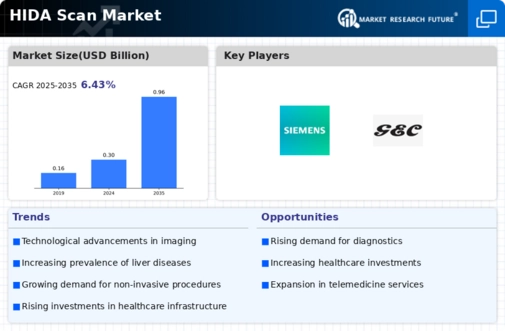Market Growth Projections
The Global HIDA Scan Market Industry is poised for substantial growth, with projections indicating an increase from 0.3 USD Billion in 2024 to 0.96 USD Billion by 2035. This growth trajectory suggests a compound annual growth rate of 11.2% for the period from 2025 to 2035. Factors contributing to this expansion include the rising incidence of hepatobiliary disorders, advancements in imaging technology, and increased awareness of nuclear medicine. As healthcare systems worldwide continue to evolve, the demand for effective diagnostic tools like HIDA scans is likely to rise, reinforcing the industry's positive outlook.
Expansion of Healthcare Infrastructure
The expansion of healthcare infrastructure, particularly in emerging economies, is a significant driver of the Global HIDA Scan Market Industry. As countries invest in modernizing their healthcare systems, the availability of advanced diagnostic tools, including HIDA scans, is increasing. This trend is particularly evident in regions where access to quality healthcare has historically been limited. The establishment of new hospitals and diagnostic centers is likely to enhance the accessibility of HIDA scans, thereby fostering market growth. The anticipated increase in market size from 0.3 USD Billion in 2024 to 0.96 USD Billion by 2035 reflects the positive impact of these infrastructural developments.
Rising Incidence of Hepatobiliary Disorders
The increasing prevalence of hepatobiliary disorders, such as gallbladder disease and liver dysfunction, significantly drives the Global HIDA Scan Market Industry. As healthcare providers seek accurate diagnostic tools, HIDA scans have emerged as a preferred choice due to their ability to assess liver and gallbladder function effectively. In 2024, the market is projected to reach 0.3 USD Billion, reflecting the growing demand for non-invasive imaging techniques. This trend is likely to continue as the global population ages and lifestyle-related diseases become more common, suggesting a robust growth trajectory for the industry.
Regulatory Support and Reimbursement Policies
Regulatory support and favorable reimbursement policies are crucial factors influencing the Global HIDA Scan Market Industry. Governments and health authorities are increasingly recognizing the importance of nuclear medicine in diagnostic imaging, leading to supportive regulations and reimbursement frameworks. This environment encourages healthcare providers to adopt HIDA scans as a standard diagnostic tool. As reimbursement rates improve, the financial burden on patients decreases, potentially leading to higher utilization rates. The projected compound annual growth rate of 11.2% from 2025 to 2035 indicates that these supportive measures are likely to enhance the market's growth prospects.
Technological Advancements in Imaging Techniques
Technological innovations in imaging modalities are enhancing the capabilities of HIDA scans, thereby propelling the Global HIDA Scan Market Industry. Advances such as improved gamma cameras and software algorithms facilitate higher resolution images and faster processing times. These developments not only improve diagnostic accuracy but also increase patient throughput in clinical settings. As a result, healthcare facilities are more inclined to adopt HIDA scans, contributing to the market's expansion. The anticipated compound annual growth rate of 11.2% from 2025 to 2035 indicates that these advancements are likely to play a crucial role in shaping the future of the industry.
Growing Awareness and Acceptance of Nuclear Medicine
The rising awareness and acceptance of nuclear medicine among healthcare professionals and patients are pivotal in driving the Global HIDA Scan Market Industry. Educational initiatives and outreach programs have contributed to a better understanding of the benefits of HIDA scans, particularly in diagnosing and managing hepatobiliary diseases. This increased awareness is likely to lead to higher utilization rates of HIDA scans in clinical practice. As the market evolves, the projected growth from 0.3 USD Billion in 2024 to 0.96 USD Billion by 2035 underscores the potential for nuclear medicine to become a cornerstone in diagnostic imaging.













Leave a Comment